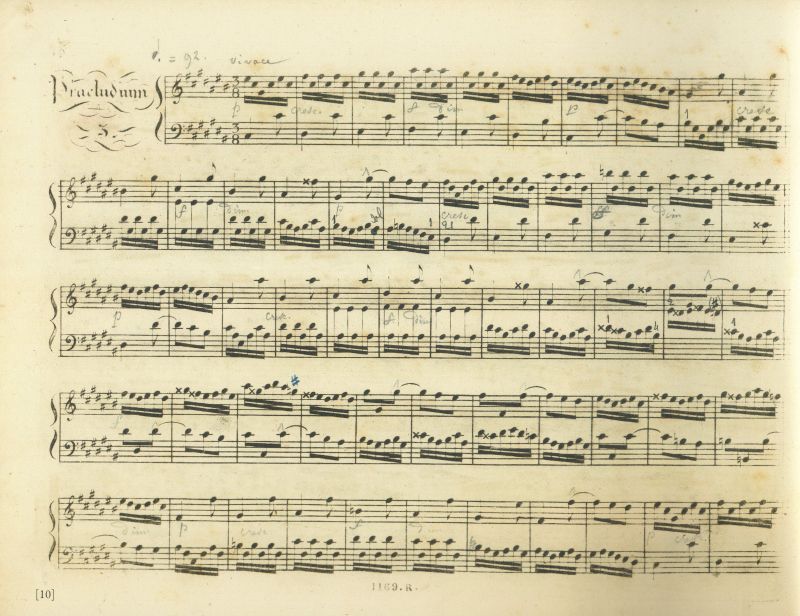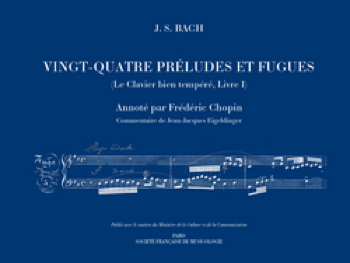|
J.S. Bach - Frédéric Chopin
Vingt-Quatre Préludes et Fugues
(Le Clavier bien tenpéré. Livre I)
Annoté par
Frédéric Chopin
Commentaire de Jean-Jacques Eigeldinger
Paris, 2020 (2nd
ed.). Format: oblong, 4° (29 x 21 cm), lxxii, 110
pp. Full-color reproduction of the Richault 1st
edition (pl. nos. 1169.R & 1168.R) with
Chopin's performing annotations. Hardbound.
$104
|
|
 |
|
|
Chopin's relation to
the cult of Johann Sebastian Bach forms an
important and compelling chapter in the
history of music—one that awaits more
detailed work in the light of new sources
and studies. How did the Polish master,
who lived during a decisive period in the
development of Bach scholarship, view the
Leipzig Cantor at various stages in his
life? What did he know of this
music, and under what circumstances did he
get to know it? Which works did he
play or hear in performance?
In his triple activity as composer,
performer, and teacher, Chopin constantly
turned to Bach as a supreme point of
reference. The Well-Tempered Clavier is
said to be the only score he took with him
to Majorca in the winter of 1838-39, at
the time he was completing his 24 Preludes
op.28—in other words, at the heart of his
career as a composer. The influence of
Bach on Chopin's compositional style is
indeed a powerful one. It can be
detected at various levels throughout his
works, from the youthful Sonata op.4 to
the late, stark Sonata op.65 for cello.
The essentially linear conception that
predominates in his development of musical
ideas—the logical, elegant voice
leading—appears to stem from an intimate
connection with the work of J.S. Bach.
Until now the important role played by the
Well- Tempered Clavier in Chopin's
teaching has been known on the basis of
literary sources. The document published
here for the first time confirms it with
living proof of a different kind, a live
record, so to speak, of his teaching. |
|
|
This precious
score, held in a private collection,
emanates directly from Pauline Chazaren, a
pupil of Chopin and teacher of Cosima
Liszt. The score was probablly
purchased in Lyons around 1843 prior to
Pauline's Parisian sojourn and was brought
or sent to Paris, where it was used in the
lessons with Chopin. The score shows
no trace of interventions that could be
ascribed to Pauline or anyone else.
Leafing through the pages of this copy of
the Well- Tempered Clavier I, one cannot
fail to be struck by the neatness with which
the signs and words indicating tempo,
metronome marks, phrasing, articulation,
dynamics, left-hand octaves, and so on, have
been notated. All of Czerny's indications
(probably taken from the 1843 Veuve Launer
edition), save fingerings, have been copied
out by Chopin. The systematic copying stops
after Prelude 7, as do the sporadic
indications in ink.
The comment made by Georges Mathias in 1897,
a professional pupil of Chopin, sheds light
on Chopin's interpretation of the masters:
"Chopin, exécutant de génie, interprétait
Mozart, Beethoven, avec le sentiment de
Chopin, et c'était très beau, c'était
sublime. Il n'était pas de la catégorie des
exécutantes critiques, historiques" /
"Chopin, a genius of a performer, played
Mozart and Beethoven in the spirit of
Chopin, and it was very beautiful, indeed
sublime. He was no critical, historical
performer"). Commentary in
Fr/Eng/Pol. Hardbound. (text
adapted from J.J. Eigeldinger)
(see
listing
of other Chopin works) |
|
|
|
Distributed by:
OMI - Old
Manuscripts & Incunabula PO Box 6019 FDR
Station, New York NY 10150
tel/fax 212/ 758-1946
http://www.omifacsimiles.com
immels@earthlink.net
|

|
|
|

